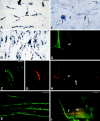BEN/SC1/DM-GRASP expression during neuromuscular development: a cell adhesion molecule regulated by innervation
- PMID: 9952415
- PMCID: PMC6786018
- DOI: 10.1523/JNEUROSCI.19-04-01382.1999
BEN/SC1/DM-GRASP expression during neuromuscular development: a cell adhesion molecule regulated by innervation
Abstract
BEN/SC1/DM-GRASP is a cell adhesion molecule belonging to the Ig superfamily that is transiently expressed during avian embryogenesis in a variety of cell types, including the motoneurons of the spinal cord. We have investigated the pattern of BEN expression during neuromuscular development of the chick. We show that both motoneurons and their target myoblasts express BEN during early embryonic development and that the protein becomes restricted at neuromuscular contacts as soon as postsynaptic acetylcholine receptor clusters are observed in muscle fibers. Muscle cells grown in vitro express and maintain BEN expression even when they fuse and give rise to mature myotubes. When embryos are deprived of innervation by neural tube ablation, BEN expression is observed in muscle fibers, whereas, in control, the protein is already restricted at neuromuscular synaptic sites. These results demonstrate that all myogenic cells intrinsically express BEN and maintain the protein in the absence of innervation. Conversely, when neurons are added to myogenic cultures, BEN is rapidly downregulated in muscle cells, demonstrating that innervation controls the restricted pattern of BEN expression seen in innervated muscles. After nerve section in postnatal muscles, BEN protein becomes again widely spread over muscle fibers. When denervated muscles are allowed to be reinnervated, the protein is reexpressed in regenerating motor axons, and reinnervation of synaptic sites leads to the concentration of BEN at neuromuscular junctions. Our results suggest that BEN cell adhesion molecule acts both in the formation of neuromuscular contacts during development and in the events leading to muscle reinnervation.
Figures




References
-
- Auda-Boucher G, Jarno V, Fournier-Thibault C, Butler-Browne G, Fontaine-Perus J. Acetylcholine receptor formation in mouse chick chimera. Exp Cell Res. 1997;236:29–42. - PubMed
-
- Bowen MA, Bajorath J, D’Egidio M, Whitney GS, Palmer D, Kobarg J, Starling GC, Siadak AW, Aruffo A. Characterization of mouse ALCAM(CD166): the CD6-binding domain is conserved in different homologs and mediates cross-species binding. Eur J Immunol. 1997;27:1469–1478. - PubMed
Publication types
MeSH terms
Substances
LinkOut - more resources
Full Text Sources
Miscellaneous
